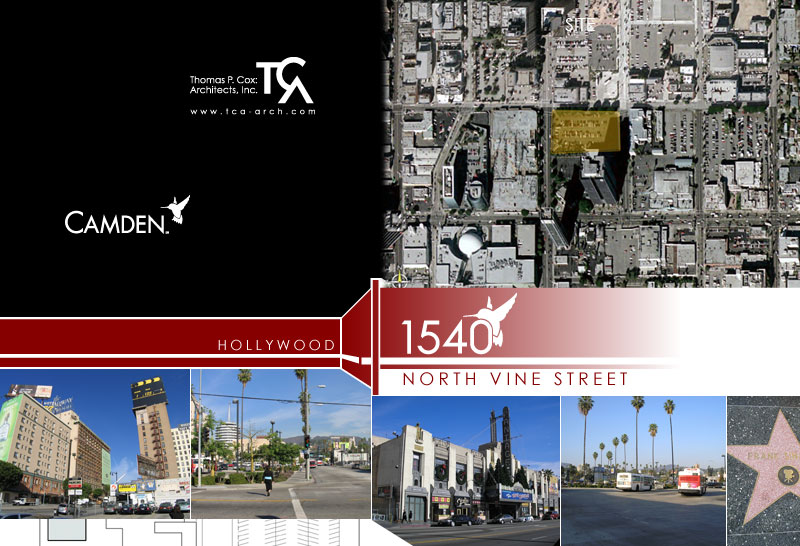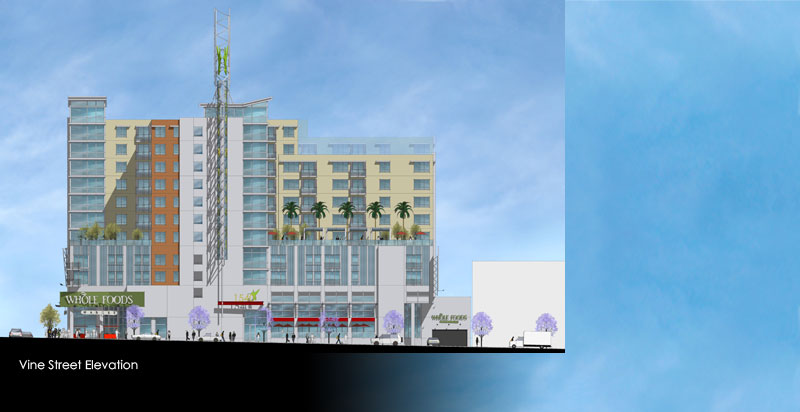


 http://www.nareit.com/portfoliomag/0...theworks.shtml
http://www.nareit.com/portfoliomag/0...theworks.shtml
Lights, Camera, Apartments
[November/December 2007]
By Allen Kenney
In 1913, legendary filmmaker Cecil B. DeMille set up shop at the corner of Vine Street and Selma Avenue in Los Angeles to create Hollywood’s first full-length feature film, “The Squaw Man.” Nearly a century later, a parking lot now covers the site.
Now, Camden Property Trust (NYSE: CPT) hopes to capitalize on the magnetic pull of the big screen to lure film buffs to 1540 N. Vine St., a planned 11-story luxury apartment building development to replace the blacktop hiding the spot where Tinseltown’s first motion picture was born.
Camden wants the apartment building—tucked in between the famous Sunset Strip and Hollywood Boulevard—to evoke the glamour of 1940s-era Hollywood. While trying to maintain a contemporary ambience, the developers sought to create a classic Hollywood feel through the building’s architecture and signage. Architectural firm Thomas P. Cox: Architects, Inc. modeled the building’s design after local landmarks like the Roosevelt Hotel. Adding to 1540’s sense of history, the building site is located along the Hollywood Walk of Fame and will feature sunken relief sculptures along the building’s base depicting the filming of “The Squaw Man.”
The 300-plus new rental apartments should attract young, urban professionals “who like the notoriety of living in Hollywood,” says Rick Holcomb, vice president of real estate investments for Camden, who spearheaded the project. Holcomb notes that the development will be located in the diverse, up-and-coming area of East Hollywood.
Hollywood Makeover
The 1540 site lies within the Hollywood redevelopment zone run by the Community Redevelopment Agency of the City of Los Angeles (CRA/LA), a public agency created to “attract private investment into economically depressed communities, and to eliminate slums, abandoned or unsafe properties, and blight throughout Los Angeles.” CRA/LA’s efforts in Hollywood started in 1986, and the agency has participated financially in a number of private business projects in the area. Once one of Los Angeles’s most dangerous neighborhoods, some developers are now angling to transform Hollywood into an upscale residential area.
Southern California developer Bond Companies, for instance, has experienced success with a five-story mixed-use site at the corner of Vine and Sunset. The 750,000-square foot property features houses 300 apartment units and features retailers like Borders and Bed Bath and Beyond.
Just down the road from 1540 at the corner of Hollywood and Vine, Legacy Partners and Gatehouse are in the midst of building a 4.6-acre site that will include a new W Hotel, as well as condominiums and rental apartments. “It’s a very happening place,” Holcomb says.
A Perfect Fit
Construction on 1540 is expected to begin before the end of 2008, with units going into service by the end of 2010. Camden has aspirations of expanding its prescense in Southern California, making 1540 a key asset, according to Holcomb. The company currently operates 186 apartment properties across the country, including 10 communities in the San Diego, Orange County and Los Angeles regions. The Hollywood project is one of 11 new ventures in Camden’s $2.2 billion national development pipeline.
“There is a clear supply-demand imbalance in Southern California, and there’s a real need for rental housing in this market,” Holcomb says. “The existing development pipeline can barely keep up with the demand for what’s needed.”
Holcomb cites Whole Foods’ participation in designing 1540 as one of the property’s biggest advantages. To satisfy the mixed-use component required for approval of the building plans, Camden partnered with the popular high-end grocer to design a space on the ground floor for a new store. Holcomb points out that Whole Foods’ participation is a huge plus for the property, beyond the visibility that the grocer’s brand name brings.
“We were very fortunate to have a lease in place with Whole Foods and have them cooperate with us in our design process in order to deliver a very functional store that is going to be quite a success,” Holcomb says, noting that many developers of mixed-use properties are forced to begin building without a retail tenant in place, hoping to lease the space out later. “We’re not spending substantial money on a store without knowing who our tenant will be.”
Another selling point is that 1540 is located less than a block away from a subway stop offering residents a 10-minute ride to downtown. The proximity to the subway station should seem even more appealing to passengers stuck in the estimated 170,000 cars crawling through the parking lot that doubles as Highway 101 during rush hour. The development site is just west of the freeway.
“Our residents will be able to walk a half-block, get on the train, take a 10 minute ride, and they’re right downtown where many jobs are located,” Holcomb says. “That’s a huge benefit with all the traffic congestion we have in Southern California.”
Making Its Debut
As many movie producers have discovered while bringing their box-office blockbusters to the big screen, the road to building 1540 proved difficult after Camden began to target the site three years ago. Holcomb likens the labyrinthine maze of bureaucracy in California to “skin on an onion.”
He notes that his team had to take part in more than 70 meetings with almost 20 different agencies in order to get the project up and running.
Holcomb readily admits that 1540 is a little out of character for Camden. He describes the company’s “bread and butter” as being “300-unit suburban communities that are three-story walk-ups.” However, he says, Camden is increasingly branching out into higher-density, urban projects like this.
Regardless of size, Holcomb contends that the long-term financial rewards will be great, enough so that Camden has been working through California’s complicated land entitlement process for more than three years to complete the deal. Holcomb quickly dismisses the idea that Camden is using 1540 just to make a splash.
“We’re not flashy,” Holcomb asserts. “This is going to be a signature property, but that’s not why we’re pursuing the deal.”
If so, Camden should probably hope to emulate the success that DeMille had on that site. “The Squaw Man” raked in $200,000 in worldwide ticket sales; it cost $15,000 to produce.